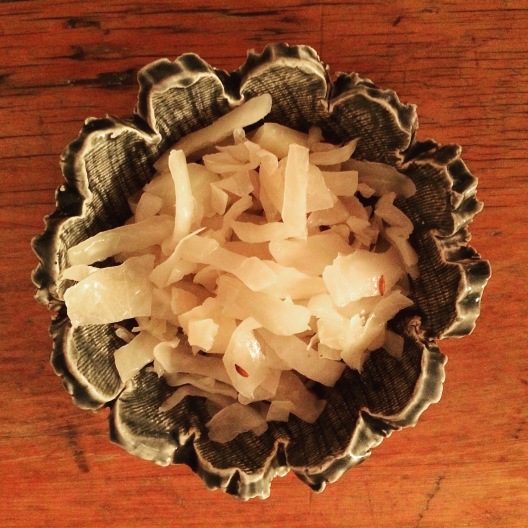
At the start of the year I began an experiment. It started before this experiment of writing about Marge’s chemo culinary journey and, looking back, was probably the seed that blossomed into the blog as it stands today. As I’ve already mentioned, as Mum’s treatment tiptoed ever closer, I felt an innate urge to do my bit to both assist her recovery and aid her determined and positive mindset. I started to research healing foods, both in their natural state and how we can use and manipulate certain ingredients to enhance their powerful properties. And there was one thing that came springing up time and time again: fermented foods.
Fermented foods come in a number of forms – from yoghurt to kimchi to sauerkraut to kefir – and their list of health benefits is even longer. Fermentation is a metabolic process in which microorganisms, for example bacteria, yeast or fungi, convert organic compounds, normally in the form of carbohydrates, into alcohol or acids. Not only is fermentation as excellent preservative and can add a real tang and gutsy flavour to your meals, but it also adds microbes to the gut, giving us a healthy dose of ‘good’ bacteria, increases micro-nutrient levels, especially that of B-vitamins, and makes food more easily digestible. Added to this, fermentation is thought to eliminate anti-nutrients, those natural or synthetic compounds that interfere with the absorption of nutrients.
So there was really no excuse – rather than moping around lamenting Marge’s diagnose, I needed to take action, ferment-action (sorry)! I decided to ease myself in gently and chose a recipe that was not only joyfully easy but also gave me the chance channel my inner German (those that know me are aware that I have a mild – or, if I’m being honest, extreme – obsession with all things Deutsch): Sauerkraut.
Pickling cabbage in a brine solution (also known as lacto-fermentation) promotes the growth of gut-friendly bacteria and homemade sauerkraut is is richer than its shop bought counterparts in the enzymes that support a healthy gut. Insufficient of unbalanced levels of ‘good’ microbes in the gut not only affects digestion, but has been linked with a number of health issues: intestinal and bowel conditions such as ulcerative colitis and irritable bowel syndrome; immune disorders including allergies and type 1 diabetes; and metabolic diseases, for example type 2 diabetes and obesity. There have also been indications from a number of studies that consumption of fermented foods can help to reduce the risk of cancer and improve emotional health, two side effects that are much needed at this time. Plus, of course, this preserving technique helps to maintain the health boosting properties of cabbage.
Marge always did enjoy getting pickled, but now (rather than on cava), she was going to experience a whole new meaning of the word…
Healing Ingredients
Cabbage is an incredibly balancing and grounding food. It has been shown to clear the blood, boost skin health due to its high levels of vitamins C and K, and is a remedy for ulcers thanks to its ample amounts of vitamin U. It also supports liver function as it stimulates the production of glutathione (which plays a role in liver detoxification), is anti-parasitic due to its high sulphur content and helps to promote bowel regularity.
Recipe: Sauerkraut
Makes 1.35kg.
- 2.5-3kg hard white, red or green cabbage
- Approx. 60g coarse sea or rock salt
- 1 tbsp caraway seeds
Method.
- Remove the outer leaves of the cabbage, reserving them for later, slice the cabbage in half, remove the cores, quarter and shred finely using a food processor or sharp knife.
- Weigh the cabbage and calculate the amoutn of slat you need – approx. 60g of salt per 2.5kg of cabbage
- Place the cabbage in a large, clean bowl and sprinkle in the salt evenly. Massage the salt into the cabbage until it begins to feel wet. Leave for a few minutes for the salt to draw out the water and soften the cabbage.
- Pack into a large, sterilised jar. Add 5cm of the cabbage at a time and scatter with the caraway seeds, packing each layer down with the end of a rolling pin or large pestle. Leave 7.5cm at the top of the jar.
- Add any juices from the bowl and top up with cold brine (1 1/2 tsp salt to 1 litre boiled, cooled water) so that the cabbage is covered.
- Place a clean muslin over the cabbage and place one of the larger outer leaves of the cabbage over the surface. Place a large jar or sandwich bag filled with water on top.
- Leave in a well-ventilated place at room temperature (ideal temperature 20-22°C, below 13°C and fermentation will stop, above 24°C and it will spoil). Check everyday that the cabbage is submerged. Remove any scum and replace with a clean muslin.
- Leave for around 3-4 weeks – fermentation is complete when all the bubbling has ceased. Store in clean, sterilised jars in the fridge.
For more information on fermentation see: https://www.choice.com.au/food-and-drink/nutrition/superfoods/articles/fermented-foods